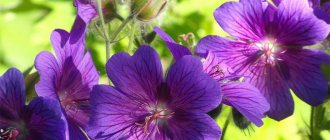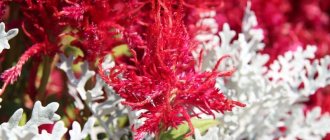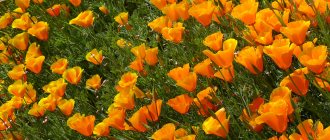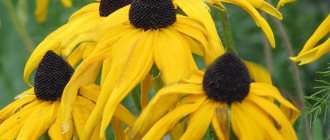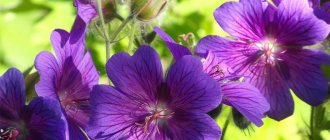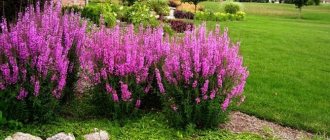In Europe, this ground cover shrub is planted to decorate streets, parks and squares. Euonymus can beautify any area, because from it you can create an evergreen carpet, border strip and a chic flower bed.
Increasingly, landscape designers use this shrub to create various compositions, and gardeners simply decorate their garden lands with it.
About the plant
Euonymus belongs to the genus of woody plants. The shrub belongs to the family Celastraceae, or Euonymus. The name of the plant comes from the Greek word euonymus, which literally means “glorious”, “with a noble name”. The name of the Euonymus species is inextricably linked with the name of the scientist who first described this shrub.
Synonyms in biological taxonomy related to this genus of plants:
- Evonymus;
- Kalonymus;
- Pragmotessara;
- Pragmotropa;
- Quadripterygium;
- Sphaerodiscus.
Once upon a time, the word “Euonymus” referred to the feminine gender, therefore in botanical literature until 2010, the euonymus was designated as “Euonymus europaea”. In Slavic culture, euonymus was called differently.
For example, in Dahl's dictionary there are the names bereskled, night blindness, kislyanka, zhigalok, bruchmel.
This plant is often found in the shade of forest zones, mixed and broad-leaved thickets, and parts of river valleys. Often found in the tropics and subtropical zones. Euonymus is not found in cold northern regions.
Almost half of the euonymus varieties are evergreen and their leaves are of the same color. For example, Fortune's euonymus, originally from China, always has green leaves. Certain euonymus shrubs are deciduous and in certain seasons their leaves turn yellow and fall off.
Botanical certificate
Characteristics common to most plants in the family are small trees up to 10 m in length. The shoots have round or rectangular sections, prone to rapid lignification.
The leaves on the shoots grow with a smooth surface. The foliage color is completely green or variegated. The outlines of the veins are clearly visible on each leaf.
The flowers of this plant often look inconspicuous: the petals are light green or brownish-pinkish. At the moment of flowering, the plant emits a rather pungent, specific aroma. When the bud is pollinated, a box appears in its place, resembling an inflated cushion-fold.
The ripe leaf acquires a burgundy, crimson, orange or purple color. After this, the valve opens and the seeds can be seen. Euonymus fruits look very bright and appetizing, but they contain poisonous alkaloids.
Since deciduous and evergreen euonymus can be found in nature, landscape designers prefer to choose green varieties to decorate public gardens and alleys.
And varieties that change color depending on the seasons can often be found in parks and summer cottages. In addition, you can plant indoor euonymus and care for it in your apartment.
Despite the fact that there are more than 200 species of this shrub, only 20 varieties of euonymus grow in Russia, including in Siberia and the Urals.
Also, some varieties of this plant may be suitable for landscaping parks, cottages and for growing in apartments.
Winged euonymus: king of the autumn garden
Peculiarities
The plant can be represented under the name eonymus. The culture belongs to the euonymus family, which includes more than a hundred varieties from miniature bushes to medium-sized trees. In the wild, the plant can be seen in East Asia, Europe, Australia, North America and Madagascar; some forms grow in China. In Russia it grows in the Urals, in the middle zone, and in the Far East.
The shrub can reach a height of 7 m. The flowers are usually compact, their color varies depending on the variety and variety. The number of inflorescences is up to 5 pieces. The fruits are formed in dry boxes. The culture has medicinal properties, but the berries are very toxic due to the content of alkaloids, so it is recommended not to plant if you have small children.
Varieties of euonymus for the street with photos and descriptions
From such plants you can create amazing landscape compositions in Japanese, French, English styles and rustic rosewoods. These varieties of shrubs are gas-resistant, so they are ideal for beautifying the city.
Fortune's euonymus . An evergreen creeping shrub, reaching a maximum height of 60 m and a length of up to 3 m. This evergreen plant comes from China. Fortune's stems are in contact with the ground, thanks to which the bush is able to cling to various supports. The buds are green or white at peak ripeness. The fruits are bright yellow in color, but they are poisonous, like all of the Euonymus family. This bright, variegated evergreen plant loves moist, fertile soil. Withstands haircuts very well. Suitable for landscaping parks, gardens, squares.
Euonymus Winged . The natural distribution zone of this shrub is Korea, China, Japan. A low branched shrub, Euonymus Winged, does not grow above 1 m in height and 2-3 m in diameter. The plant changes its color from bright green to fantastic burgundy in autumn. Blooms with bright yellow flowers. In autumn and winter, this variety of shrub bears bright, poisonous orange or burgundy-red berries. Usually the colored boxes hang on the bush until February, then they crack, exposing the orange seeds. The bushes tolerate well-drained soils with varying pH levels. They decorate rocky hills and borders, since this variety of euonymus can be trimmed.
Euonymus dwarf . The distribution area of the shrub is quite extensive - from Europe to Asia. The dwarf euonymus is listed in the Red Book as it is an endangered species. Under natural conditions, the shrub has practically lost its ability to reproduce. The height of a dwarf shrub usually does not reach 1 m, and the width is 1-2 m. The foliage is dense, leathery, elongated at the edges, with small teeth. The leaves are bright green above and bluish below. The flowers are brownish-light green. The fruits of the bush are flattened, yellow-green, sometimes with a pinkish tint. Euonymus dwarf is frost-resistant and easy to care for, so it can be used to landscape city park recreation areas, plant near buildings, and improve borders.
European euonymus . The RedCascade bush is considered one of the best shrubs for decorating the street in the autumn-winter period. European euonymus, or Bruslina, will help transform any area, transforming a nondescript lawn into an autumn red-pink landscape. Under the weight of the fruits in November, this bush takes on a weeping shape. The RedCascade shrub at its peak reaches 3-4 m in height and 2-3 m in width. In summer, Bruslina's foliage looks discreetly green, but in autumn the bush changes significantly and becomes crimson-red. The plant takes root well in bright sun and partial shade and does not like drought. This euonymus is resistant to exhaust and smoke, so it can be used to decorate city streets.
Euonymus Maak . This plant is found in deciduous forests, river and lake valleys, as well as in sandy loam areas of China, the Far East and Siberia. This euonymus plant grows up to 10 m. The leaves of the Maaka bush are large, smooth, ovate, with finely serrated edges. The buds are white and light green, collected in semi-shaped inflorescences. Maaka blooms only 4 years after planting in the ground. The plant is light-loving, cold- and drought-resistant.
Euonymus warty . In its natural environment, this shrub grows in the forests of Eurasia. Euonymus warty is considered one of the largest trees of its species. Its height is usually at least 4 m. In the wild, the bushes grow up to 10 m. The foliage of this euonymus is greenish, epileptically pointed, with denticles along the edges. By September, the leaves begin to take on a bright orange hue. The bush may not shed its leaves for a long time, and the flowering period occurs in the spring. The flowers are collected in racemes, where there can be up to 10 buds. The color of the petals is greenish-brown with purple splashes. The shrub tolerates cold winters well. Euonymus is drought-resistant, but you need to constantly maintain soil moisture.
Euonymus Fortune
Reproduction of Fortune's euonymus
Fortune's euonymus can be propagated in several ways:
- dividing the bush;
- seeds;
- cuttings:
- layering.
Gardeners choose the best method for themselves.
Cuttings
Planting material is harvested in the summer from green and non-lignified shoots. Cut cuttings 10 cm in size and plant them in a container with fertile soil, pre-treated with a root growth stimulator. A cap is made of polyethylene on top and placed in a shaded place. After 30 days, Fortune will give roots. The cuttings are transplanted to the wintering site, and in the spring they are moved to the site.
Seed method
Before planting seeds, they are treated with a 5% solution of potassium permanganate. Sown in turf soil mixed with river sand. After three months, shoots will appear and they will be planted in separate containers. They remain in this state for 30 days, then they are placed in a certain place on the site. Sowing of seeds is carried out at the end of January. You can plant the seeds directly into the ground in the spring; by autumn they will sprout; for the winter, the young shoots are covered in a mini-greenhouse.
Dividing the bush
This is the most effective way to breed euonymus. An adult plant is dug up. Divide the root system into the required number of parts. Each lobe has a growing point, a root and several young shoots. They are planted around the area.
Reproduction by layering
Fortune's creeping euonymus reproduces by layering in the wild. Upon contact with the soil, adventitious roots on young shoots take root. They are separated from the main bush and planted on the site. You can propagate Fortune's euonymus yourself. To do this, dig in an annual shoot, it produces roots, divide it, and plant it in a permanent place.
Fortune's euonymus is a low-growing creeping shrub with an attractive and bright crown. An ornamental plant is grown to create landscape compositions. Euonymus is unpretentious in care, tolerates low temperatures well, and is undemanding to lighting and watering.
Varieties suitable for growing at home
Euonymus can be grown at home if it is not possible to plant a shrub in the country house or garden. There are miniature varieties that are easy to care for. It is enough to maintain soil moisture and regularly remove weeds.
Euonymus Japanese . In nature, this Asian shrub can grow up to 8 m, but, nevertheless, it can be planted at home. Japanese euonymus is not suitable for growing in open ground in central Russia due to intolerance to low temperatures in winter. The dwarf Japanese euonymus has variegated, greenish-yellow leaves. The plant is unpretentious in care: it takes root well in partial shade. But you shouldn’t put it in the most heated room in winter - the euonymus can shed its leaves.
Fortune's euonymus . An ideal option not only for landscaping garden plots, but also for decorating rooms in the house. Since the plant can grow up to 3 m in height, it is advisable to trim it. You can grow Fortune on the plot in the summer, and bring it indoors with the onset of the first frost. Often this shrub is placed as decoration on loggias, attics and balconies.
Koopman's euonymus . A dwarf shrub is ideal for home decoration. The maximum grows to a length of 1 m. Koopmana has green ribbed shoots. A creeping shrub with elongated leaves from 1 to 5 cm. The flowers are painted green - they grow in semi-umbrellas or singly.
I am planting ERUPONUS FORTUNA Do not confuse it with Vinca!!!
Euonymus: photos of examples of landscape design of plots
The presence of a wide variety of original species and varieties of euonymus allows it to be widely used when creating the decor of personal plots. It can be used individually or in group combinations with other plants. Euonymus allows you to create both lawns and miniature hedges. For use in group compositions, large, spreading specimens are most often taken.
Euonymus in the design of a decorative hedge
Euonymus in landscape design of a personal plot
Tall varieties are used in the background when creating flower beds, while dwarf varieties decorate flower beds around the perimeter. Low plants can be used to create alpine slides or rockeries. Sometimes in areas where there is a lot of shade, they replace the lawn or form a border on paths that are brightly lit by the sun.
Euonymus fortunena is often used for vertical gardening.
The Fortune variety can be used for vertical landscaping. To do this, it needs to be mounted on supports. Often used on balconies, terraces and verandas. Can be planted next to low-growing conifers, dwarf barberry or dogwood. There are a wide variety of options for using euonymus in landscape design; it depends on the designer’s project, the customer’s preferences and the overall style of the garden plot.
Types of euonymus for Siberia
Not all plants can tolerate the harsh Siberian climate, but euonymus is considered one of the most resistant. Some varieties of this amazingly beautiful shrub can even withstand frosts of -40 degrees.
The most popular species, often found in the broad-leaved forests of Siberia, is the Winged. Also in the wild Siberian terrain you can see Dwarf, Maaka, Warty. These types of shrubs will take root well in summer cottages and garden plots. They tolerate frosts down to -40 °C well, so they do not need to be brought indoors for wintering.
Varieties for the Urals
The climate in this area is typically mountainous. On the territory of the West Siberian Plain with a harsh continental climate, only frost-resistant species of euonymus take root.
It is advisable to grow ornamental dwarf shrubs, such as Fortune and Japanese, outdoors in warm weather and bring them indoors in winter. In the urban Ural environment, the Winged, Dwarf, Maaka, Koopman, European and Warty will take root.
Varieties for the Moscow region
In summer, euonymus does not decorate Moscow and the Moscow region due to the fact that the color of its foliage blends in with the general mass of trees. In autumn, these shrubs become favorites for creating landscape designs in various styles.
The most popular varieties for the Moscow region are Winged and European. Also, Fortune, Maaka, Dwarf, and Japanese successfully take root in the Moscow climate.
Species suitable for southern climates
Growing euonymus in southern Russia does not require much effort. Species of this shrub take root well in hot climates. The main thing is to follow standard care - fertilizing, regular watering and weed control.
Types of euonymus for the south: Winged, Dwarf, European, Maaka, Japanese, Fortune, Sakhalin, Koopman, Maksimovich. In the south you can see many landscape areas where euonymus grows, and it can also be found in nature.
Winged euonymus. Autumn fairy tale. Video:
Winged euonymus. Autumn Tale
Landing algorithm
Outdoor euonymus, seedlings of which already have a closed root system, can be planted at the following time intervals:
- In spring from April to May.
- In summer from June to mid-July.
- In autumn, in September, before frost sets in.
If the cutting has an open root system, then planting occurs at the end of March - beginning of May. Houseplants can be replanted year-round. However, for the procedure in winter, the young seedling will need additional lighting.
Algorithm for planting outdoor plants:
- Prepare the planting hole. The size of the hole is made based on the seedling.
- A layer of drainage is laid on the bottom.
- Place the seedling at the bottom of the hole so that the root collar is above ground level. The roots of the seedling are straightened and given their natural position.
- Pour soil into the hole, lightly compacting it.
- Water generously.
- The tree trunk circle is mulched.
No other manipulations are required during planting.
Euonymus: planting and care in open ground
Like any woody plant, euonymus can be planted in autumn and spring. But it is worth taking into account that different types of this shrub require certain care.
If you plant cuttings, it is advisable to do this in the fall so that by spring they have time to take root in the ground. Planting seeds requires preliminary stratification. This method should only be carried out in early spring.
How to choose seeds?
Gardening stores provide a wide range of euonymus seeds, but you need to choose based on where the future shrub will be planted.
If euonymus is already growing on the site and has seed pods, then the seeds are removed from them. Then they are treated with a manganese solution and sown in a moistened substrate.
In winter, you need to insulate the bed if the seeds were planted in the spring. Also, the land must be stratified. Pots with seeds should be placed in the refrigerator on the bottom shelf for 4-5 months.
Thanks to this technique, the seedlings will successfully sprout at the same time. When it gets warm, around April to May, the seedlings can be planted in the garden. In open ground, young euonymus will have to be grown for 3-4 years in order for buds to appear on them.
Landing area
Depending on the type of euonymus, the area for future planting is selected. Asian variegated varieties are best planted on the sunny side. Shade-tolerant varieties, such as Japanese and Dwarf, will feel better next to other trees that create shade.
The area for the plant should be large, since the shrub is prone to rapid growth. You should avoid planting in clay soil to avoid moisture stagnation. But, if there is no other option, you can dilute the soil with drainage.
Landing
To properly plant euonymus, holes should be dug in advance. This is necessary to prevent excessive penetration of seedlings into the ground when the soil settles. It is important to mix the soil with drainage.
It is advisable to fertilize with rotted manure with the addition of mineral fertilizers. Before sending the plant into the ground, it is advisable to dip it in a mixture of clay and potassium permanganate.
After planting, the soil around the seedling needs to be compacted. Then the soil is mulched and watered abundantly. All euonymuses love humus-rich, moist, slightly alkaline soil. If the soil is too acidic, it can be limed. Sand mixed with humus can dilute heavy clay soil.
Shrub care
It is recommended to regularly water only young bushes, and adult euonymus require additional watering only in times of drought. During the season, the number of waterings is reduced to 3-4.
The same number of times you need to loosen the soil around the euonymus trunk. To improve soil aeration, the soil needs to be regularly weeded and the mulch updated.
In the spring, you need to fertilize euonymus, since it is during this period that the shrubs are especially lacking in nutrients. It is advisable to fertilize with organic matter. To stimulate flowering, it is worth adding inorganic fertilizers to the soil. It is desirable that potassium, phosphorus and trace elements predominate in the composition.
In early spring, you need to trim off branches that spoil the appearance of the bush - this is easy to do even for a beginner.
To give the euonymus a cone shape, you will have to practice a lot, but the result is worth it - you get a beautiful landscape decoration.
Euonymus cuttings. How to propagate by cuttings. Video:
Euonymus cuttings. How to propagate by cuttings.
Diseases and pests
Insects quite often become a problem when growing this plant. The most common pests are aphids and mealybugs.
Sometimes the plant becomes a victim of various diseases. Most of them are caused by non-compliance with the rules of agricultural technology. So, if the soil is waterlogged, it is possible to encounter powdery mildew. You can recognize the disease by a white coating and drying out of the crown.
If brown stains are observed on the leaves, then it can be assumed that the crop is affected by brown spot. Both diseases are treated with fungicides. The most effective products are considered to be “Peak”, “Hom”, “Skor”, “Abiga”.
The most serious disease for the plant is called mosaic. The presence of the disease is indicated by the formation of yellow spots and deformation of the leaves. If infected, there is no point in treating the affected specimen - all that remains is to dig it up and dispose of it as soon as possible.
Planting and care at home
Caring for euonymus at home will not be difficult; the main thing is to remember that this plant should not stand in an overly heated room in winter, because warm air can destroy it. In other cases, depending on the variety, euonymus loves sun or partial shade.
Variegated varieties most often love the sunny side of the apartment; they need this to preserve their color. Solid leaves can easily turn green in partial shade.
Planting and care
It is recommended to replant the euonymus annually in the spring, when the bush begins to actively grow after hibernation. This procedure is necessary for shrubs up to 5 years old. If the euonymus is older, then it can be replanted once every 2-3 years.
The soil is suitable for the shrub if it is light and sufficiently moist and dense enough in the root zone. The plant is unpretentious in choosing a specific soil. Best land option:
- purchased soil for indoor flowers;
- earth with humus, leaves and turf in a ratio of 2:1:1, you can also add sand to this mixture;
- turf, peat and sand in a ratio of 3:0.5:0.5.
Choosing a pot and replanting
For the proper development and growth of the plant, the container plays an important role - it is advisable to choose a shallow one, but wide enough.
By the way, look at the previous article. There is a lot of useful information for you - Deytsia: planting, care and cultivation in open ground.
Large shrubs will feel good in ceramic containers, as excess moisture evaporates better from them.
To prevent the bush from growing and looking compact, you can resort to a trick - do not increase the size of the pot when replanting, so that the plant develops more slowly.
Before planting, the pot must be doused with boiling water to disinfect it, and the drainage and substrate must be heated. The drainage is placed in a layer of 2-3 cm at the bottom of the container. Carefully transplant the euonymus from the old pot into a new one without damaging the root system.
Then you need to add new soil to fill the empty areas. After replanting, the plant needs to be watered and placed in partial shade, and when the bush takes root, move it to the sunny side.
Watering and fertilizing
It is advisable to actively water the euonymus from spring to autumn. The water must be settled, warm, melted or filtered. When the top layer of soil begins to dry out, this is a sign that the euonymus needs watering.
In hot weather, you can spray the leaves, but only with soft water. It is also important to keep the foliage clean - it should not be dusty.
With the arrival of frost, watering should be reduced. Exceptions include euonymus plants standing in heated rooms with dry air. If the plant overwinters on a glassed-in loggia, then it should not be watered at all.
It is advisable to fertilize during the period of active shoot growth, ripening of buds and seed pods. Standard mineral complexes are suitable as fertilizers. They should be added to irrigation water once every three weeks.
How to plant?
The presented culture is a fairly simple and unpretentious plant for growing in various regions with cold winters. Even in Siberia it is possible to maintain shrubs.
Before planting a plant, you should choose a suitable location. The tree develops best in areas that are protected from the wind and well lit by the sun; the plant will also feel comfortable in partial shade. If variegated varieties are planted, then you need to choose the most illuminated flower bed. When planted in the shade, the crop will develop poorly, and the shade of the foliage will not please you with its brightness.
The most favorable time is spring or mid-October. If you plan to plant a specimen with a closed rhizome, then the procedure can be performed throughout the entire season. When planting, it is important to consider the shape of the future shrub. There are species that grow very well, so it is advisable to maintain an interval of 1.5-2 m between plantings.
Suitable soil is slightly alkaline, fertile soil with medium acidity. You can select an area with shallow groundwater. The first stage of planting is digging a hole. The dug soil should be mixed with compost. Expanded clay or broken brick is immersed at the bottom as a drainage layer. If the ridge is not clayey and is enriched with sand, then the drainage system can be omitted.
The next layer is a previously prepared mixture, into which the seedling is planted so that the root collar is located at ground level. Now the planting site is compacted and well moistened.
Experienced summer residents advise placing a layer of mulch around the seedlings, which will retain moisture in the ground for a long time, prevent the development of weeds, prevent the roots from overheating, and prevent the formation of fungus, which ground cover species are especially prone to. You can use bark or wood chips as mulch. After just a few weeks, active growth should be observed.
Room care
Caring for indoor varieties of euonymus is simple. This is due to the conditions in which the plant grows. Indoors it is easier to control humidity, lighting and watering.
Spraying and watering
Watering at home is done regularly, as soon as the top layer of soil dries out. If liquid accumulates in the pan, it is not allowed to stagnate, but is removed immediately. For irrigation, water must be settled.
In winter, these procedures are reduced. In hot weather it is necessary to maintain air humidity. Therefore, if the room is stuffy, the air should be irrigated with a spray bottle.
Top dressing
Indoor euonymus is fertilized only in spring and summer. Feeding regime: once every 30 days. For home bushes, a complex mineral composition is used, suitable for decorative foliage plants.
Trimming
The euonymus in the photo may look like a bonsai. All indoor species can be made miniature and very beautiful. To do this, it is necessary to do timely pruning, leaving one trunk.
Topping
Pinching is done only on young seedlings. The procedure is done in March. Thanks to this, the crown of the plant will be lush. Also, if desired, you can make a standard tree out of it. To do this, pinching is done systematically to awaken the sleeping buds.
Transfer
Replanting an indoor variety is done as soon as the pot of the plant becomes small. A container is prepared for the procedure. Its size should be larger than the size of the seedling's earthen ball. After this, drainage is placed at the bottom of the pot.
The plant itself is transplanted using the transshipment method. Until the bush is 5 years old, replanting is done annually. If the plant has many cuttings, then they are separated. The euonymus should not be allowed to be crowded in the pot.
Outdoor care
An outdoor plant will require a little more care than an indoor plant. Therefore, there is a slight difference between seemingly identical varieties.
Spraying and watering
Euonymus (photos show all types of plants as unpretentious) like moderate watering. Moisturize it in the morning or in the evening when there is no dew. Watering should not be done when the sun is at its zenith. Water getting on the leaves of a bush can cause burns.
It is worth considering that the watering regime depends on weather conditions. If the weather is dry, water the plant 2 times a week. During the rainy season, watering is, on the contrary, reduced or eliminated altogether. Excess moisture can cause fungus or powdery mildew.
Top dressing
Feed the bush only 2 times per season:
- In the spring, nitrogen-containing fertilizers are applied.
- At the beginning of autumn - feed with phosphorus-potassium compounds.
You can also do foliar feeding.
Trimming
Pruning depends on the variety of euonymus. Most varieties do not need shaping. It is enough to sanitize the bush and remove unnecessary, dead shoots.

